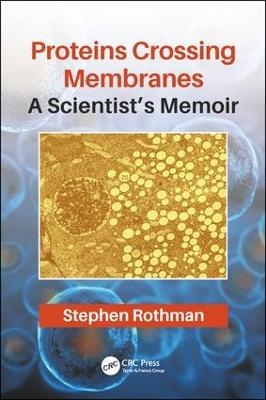
Proteins Crossing Membranes
CRC Press (Verlag)
978-0-367-07449-4 (ISBN)
In an intriguing series of experiments carried out many years ago, a common scientific belief, feted by no less than three Nobel prizes, was brought into question. The observations were about proteins—the molecules that the genetic code specifies and that are in one way or another central to all of life’s activities. The experiments however were not about what proteins do, but how they are moved, in particular how they are moved from where they are made to where they act. The results of these studies conflicted with the standard view of how this happens, and thus became controversial.
The standard view, the vesicle theory of protein secretion, envisions proteins being carried within and out of cells en masse in membrane-bound sacs or vesicles. The controversial experiments demonstrated that to the contrary individual protein molecules cross the relevant membranes as a result of their own motion. This was thought to be impossible at the time. Proteins Crossing Membranes is a personal narrative that tells the story of the controversy. Among other things, the author illustrates that scientists, like the rest of us, can rigidly hold onto their beliefs despite evidence that they are misguided.
Key Features
Reviews the data in support and critical of the vesicle theory of protein secretion
Explores the ways scientists respond to evidence that challenges a favored theory
Documents the author’s personal experiences in this conflict-laden situation
Stephen Rothman is an Emeritus Professor of Physiology at the University of California, San Francisco. He has written three books devoted to the topic of limitations of the reductionist scientific enterprise in biology. Lessons from the Living Cell: The Limits of Reductionism (2002), was an evaluation of reductionism as a research strategy. Life Beyond Molecules and Genes: How our Adaptations Make us Alive (2009), was about reductionism as a means of explaining life, of determining whether something is living. And, The Paradox of Evolution: The Strange Relationship between Natural Selection and Reproduction (2015), discusses the adequacy of reductionism as an instrument of description for evolution. All three are unusual in that they concern points of view that many think are well settled. This new book deals with the vesicle theory, which explains the basic structure and function of cells, but about which there remain reasons to doubt. Rothman studied at the University of Pennsylvania in the 1950s and subsequently taught and carried out research as a professor at Harvard Medical School. From the early 1970's until his retirement he was a professor at the University of California, San Francisco. His research covered a wide range of topics from molecular to whole-animal biology. He and his colleagues published some 200 articles in scientific journals including Nature and Science. As a senior member of the faculty at two of the most prominent medical schools in the world, he was most well known for his pioneering studies on the transport of protein molecules across biological membranes. During the 1980s, he was responsible for developing life-science activities for a synchrotron at Lawrence Berkeley Laboratory. He founded and served as CEO, CSO and Chairman of the Board of Genteric Corporation, a small biotechnology company in the Bay Area that pursued innovative methods of gene therapy.
Preface. Praeludium. SECTION I: INTIMATIONS AND FOREBODINGS. Chapter 1: At the Bench -- Watching and Learning. Chapter 2: An Indifferent Student -- Of Clams and Starfish. Chapter 3: The Dark in the Window -- The Real Thing. Chapter 4: The Observant Dr. Pavlov -- Digestion, Saliva and Hormones. SECTION II: ON THE VERISIMILITUDE OF SIMULACRA. Chapter 5: The Structures -- The Cell Seen in the Electron Microscope. Chapter 6: Micro-vesicles -- Imagining Tiny Goings-on. Chapter 7: Secretion -- Granules Popping out of Cells. Chapter 8: To See, We Must Transform – What Are You Really Looking At? Chapter 9: Making Things Whole -- To Get Beyond Speculation. Chapter 10: The Search for Dynamics -- The Theory Examines Itself. Chapter 11: Location, location, location – Where Am I? Chapter 12: Making the Impossible Real -- Could the Impossible, Be Possible? SECTION III: NATURE’S WAY. Chapter 13: Testing the Theory -- Testing The Already Known. Chapter 14: Ring the Tocsin -- Into the Fray. Chapter 15: The Clarion Call -- The Impossible Takes Place. Chapter 16: The Membrane Revolution - When is a Revolution not a Revolution? Chapter 17: The Case of the Disappearing Granules -- Extraordinary Evidence. Chapter 18: What Just Happened? -- What Didn’t Happen. Chapter 19: Irreversible -- The One-way Street. Chapter 20: Resurrection -- The Report of Death was Premature. Chapter 21: Pandora’s Box and the Back Door – Now Look What you Have Done! SECTION IV: REIFICATION AND ATTITUDES. Chapter 22: Expunging Heterodoxy -- No you don’t! Chapter 23: The Visit -- The Unwelcome Guests. Chapter 24: Rejuvenation -- What now? Chapter 25: The Impossibility of It All -- On the Coherence of Theory. Chapter 26: The Complexity Excuse -- Avoiding Ockham’s Razor. Chapter 27: Beliefs -- The Beliefs of Scientists. Chapter 28: The Rise of the Careerist - Science as a profession. Chapter 29: Cronyism -- Politics in the World of Science. Chapter 30: Psyche – Why Me? Chapter 31: Carved in Stone -- Dogma. ACKNOWLEDGEMENTS. NOTES AND SELECTED READINGS
| Erscheinungsdatum | 28.01.2019 |
|---|---|
| Zusatzinfo | 12 Illustrations, black and white |
| Verlagsort | London |
| Sprache | englisch |
| Maße | 152 x 229 mm |
| Gewicht | 344 g |
| Themenwelt | Naturwissenschaften ► Biologie ► Biochemie |
| Naturwissenschaften ► Biologie ► Genetik / Molekularbiologie | |
| Naturwissenschaften ► Biologie ► Zellbiologie | |
| ISBN-10 | 0-367-07449-4 / 0367074494 |
| ISBN-13 | 978-0-367-07449-4 / 9780367074494 |
| Zustand | Neuware |
| Haben Sie eine Frage zum Produkt? |
aus dem Bereich


